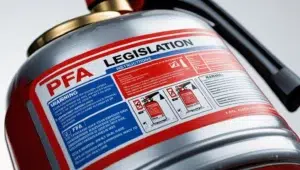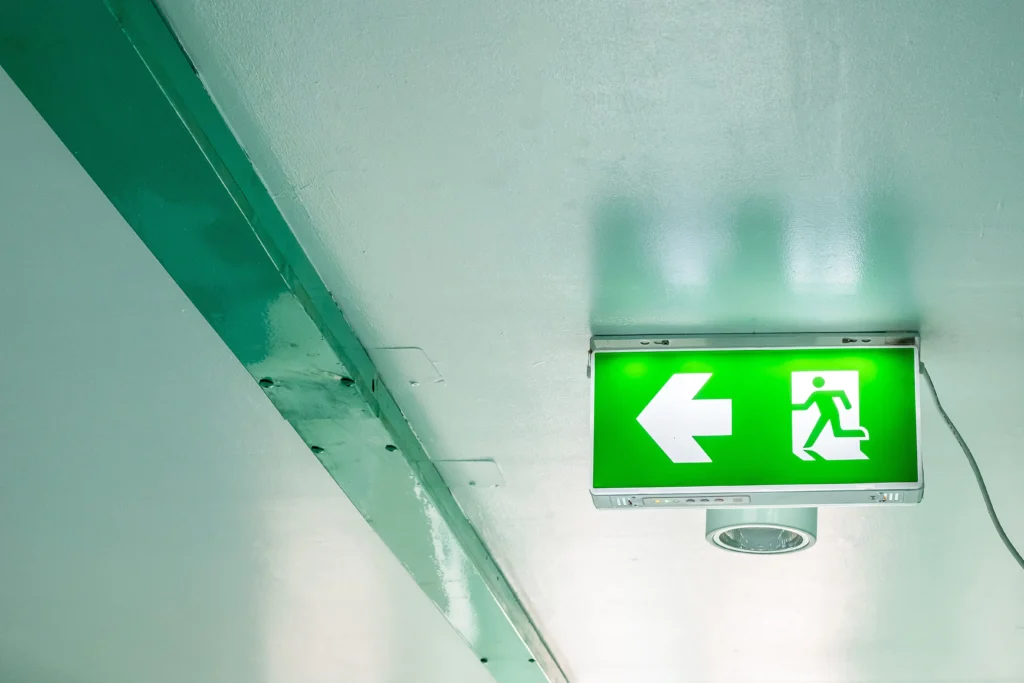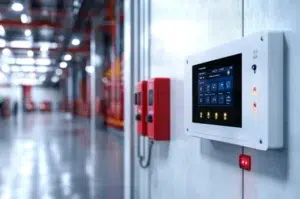
PFA Legislation – Foam fire extinguishers
Only foam extinguishers containing PFOA are banned. Many foam extinguishers manufactured post2016 are already PFOA-free, or contain alternative PFAS like C6, which are still legal.
Book your FREE, no-strings-attached Fire Safety Audit to ensure that you’re properly protected from the risk and comply with current fire safety legislation.
Get essential insights and updates
in fire safety – straight to your inbox!

Ensuring the safety of your premises goes beyond just fortifying against potential intruders; it’s equally crucial to prioritize ease of evacuation, particularly in today’s climate of heightened crime rates and fire hazards. Here are key considerations to enhance the evacuation process:
Your fire exits should facilitate swift evacuation. They should open in the direction of travel, unlatch easily with a single movement, and automatically close behind evacuees, preventing the spread of fire.
If you employ access control measures, ensure they are seamlessly integrated with your fire alarm system. This integration ensures that all doors unlock immediately when the alarm activates, eliminating any delays in evacuation. While a manual call point could be an option, every second counts in an emergency.
If alternative escape routes aren’t feasible, ensure that no point within your premises is more than 25 meters away from a primary fire exit. For businesses with a high fire risk profile, such as those involving hazardous materials, this distance should be reduced to 12 meters or less to optimize evacuation efficiency.
Ensure fire exits are clearly marked with illuminated signs and that the evacuation route is well-lit to guide occupants to safety, especially in low visibility conditions.
Conduct routine maintenance checks on fire exits, emergency lighting, and alarm systems to ensure they are in proper working order. Regularly test these systems to identify any issues and address them promptly.
Provide comprehensive training to all occupants on emergency procedures, including how to safely evacuate the premises, the location of fire exits, and the proper use of fire extinguishers if safe to do so.
Take into account the needs of individuals with disabilities or mobility issues when designing evacuation routes. Ensure that accommodations such as ramps or designated assistance areas are in place to facilitate their safe evacuation.
Prioritizing premises security encompasses more than just safeguarding against potential threats; it involves meticulous planning for swift and efficient evacuation in times of crisis. By implementing the following measures, you not only enhance the safety of your premises but also provide peace of mind to occupants.
In emergencies, time is crucial. Good preparation can save lives. Invest in strong security measures now to be ready for whatever comes.

Only foam extinguishers containing PFOA are banned. Many foam extinguishers manufactured post2016 are already PFOA-free, or contain alternative PFAS like C6, which are still legal.

Fire alarm monitoring in the UK is facing major changes due to the phase-out of traditional communication networks and providers. Analogue phone lines (PSTN) are being switched off by December

In industrial environments, safety is more than a priority—it’s a responsibility. Yet, one of the most dangerous threats to worker health is often invisible, odorless, and too often overlooked: carbon
Video Smoke Detection is perfect for a fast response to fires in high roofed buildings and harsh operating conditions.
Watch Smokecatcher detect smoke in an MSW storage building. The smoke is coming through from a fire in the adjoining storage area.
Watch Smokecatcher detect a fire in an SRF Storage bunker. Sadly, the alarm wasn’t responded to and the site lost a 4hr window of opportunity between smoke detection and flames appearing.
Video Smoke Detection overcomes the risks of stratification and other challenges for early fire detection in logistics and storage facilities.
Watch Fire Rover detect and suppress a fire in the waste bunker at an EFW facility!
See how the Fire Rover detects and suppresses this fire at a clients tipping hall. Note how the smok is spreading out at low leve, rather than rising. This is called ‘stratification’ and is one of the many reasons why roof-mounted smoke detection systems like beam detectors and HSSD is not suitable for many recycling applications.
Watch the Fire Rover detect and suppress a fire at a battery storage facility. This targeted and intellegent control makes the Fire Rover particularly well suited to high hazard storage applications.
Watch the Fire Rover tackle a battery fire in a tipping hall. Note how the exploding battery cells start three separate fires, which the operator individually suppresses (whilst avoiding the site operators in the vicinity).
Get essential insights and updates in fire safety – straight to your inbox!